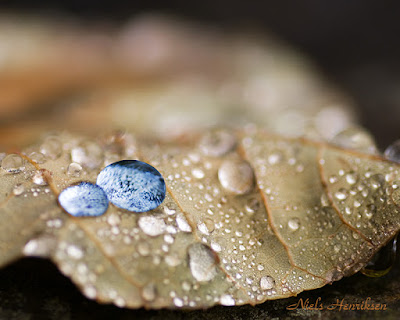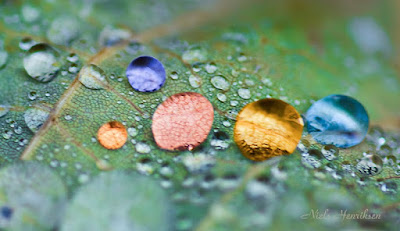The other day, while sitting on the back patio enjoying the late warmth in November, I saw this singular leaf sitting on the patio stones. You might rightly think, “well this is fall, what do you expect?” but there was something different.
It could be that the leaf was all alone but what really caught my eye was these huge rain drops sitting on top and from the angle I was looking, each drop radiated brilliant crystalline light.
The sky was lightly overcast and the droplets where reflecting the bright white sky in my direction. As I moved around the leaf the droplets would change from a silvery white to magnifying (like a lens) the patterns and textures contained under the droplet. I wonder if I could make something wonderful with my camera and ran inside to get the camera. There have been times when I have waited too long to go back to photograph an item, only to find that the conditions have changed and it was, now, no longer possible.
I wonder if I could make something wonderful with my camera and ran inside to get the camera. There have been times when I have waited too long to go back to photograph an item, only to find that the conditions have changed and it was, now, no longer possible.
There was nothing really unique about the leaf or the stone background in itself, to make an interesting composition. I decided maybe with some close-up shots I might be able, with unique perspective, to capture an interesting composition.
With that view in mind I grabbed my tripod and 90mm Tamaron Macro lens. With the aid of a cushion, I explored every inch of that leaf and probably did it several times over. It was until I was finally finished that I realized that I had taken 313 images.
With the aid of a cushion, I explored every inch of that leaf and probably did it several times over. It was until I was finally finished that I realized that I had taken 313 images. This is where the title links in. Was this an obsession or just good work on my part?
This is where the title links in. Was this an obsession or just good work on my part?
As yet, I don’t know. To be fair to myself, I was shooting macro mode and therefore focused incrementally over all parts of the leaf, in case I wanted to combine them into one clear image with greater DOF.
 I wanted to create the effect of a snowstorm in a globe that contrasted against the delicate and muted tones of the rest of the leaf.
I wanted to create the effect of a snowstorm in a globe that contrasted against the delicate and muted tones of the rest of the leaf.I did 3 different scans with the camera over the leaf and few others for artistic effect.
The one good part is that while the shooting was going on I was completely lost in my world, exploring different angles and lights and that alone was fun.
Now, what to do with all the images. I have learned not to be too obsessed with previously taken images. One day I may find a good reason to dust them off. I just need that brilliant idea to mirror with the right images.
 I enjoyed playing around with changing the colours of the drops.
I enjoyed playing around with changing the colours of the drops.For this set, I decided to select a few and see what I could do with them as I am not sure that they will all stand on their own without some retouching. There are interesting patterns and textures and in some parts, subtle colour transitions.
This is part of what makes photography interesting for me.
Niels Henriksen
Related Articles
How to adjust any color without effecting other colors.
Adjust any Colour of the Rainbow with Blend-If type Sliders















